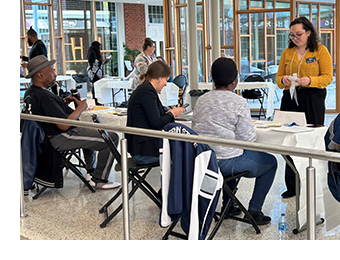ANTIRACIST DEVELOPMENT INSTITUTE HOSTS REENTRY SIMULATION SPONSORED BY RESTORATIVE JUSTICE INITIATIVE
June 2025—The Antiracist Development Institute (ADI) at Penn State Dickinson Law recently hosted a reentry simulation in partnership with Penn State College of Education’s Restorative Justice Initiative (RJI) as part of Justice Education Month.
 The event, which took place on April 17 at the Law School, gave volunteers and participants a glimpse at how challenging the first few weeks of reentry following incarceration can be. Following the simulation, an insightful panel discussion with justice-impacted individuals sparked audience engagement and a deeper look at why reentry is so difficult to navigate.
The event, which took place on April 17 at the Law School, gave volunteers and participants a glimpse at how challenging the first few weeks of reentry following incarceration can be. Following the simulation, an insightful panel discussion with justice-impacted individuals sparked audience engagement and a deeper look at why reentry is so difficult to navigate.
“Justice Education Month recognizes the impacts of incarceration on communities and creates awareness about how we can better support individuals in our spaces,” said Penn State Associate Teaching Professor of Education Efraín Marimón, director of the RJI. The organization works with justice-impacted individuals, providing support for those who are currently and formerly incarcerated.
ADI Program Manager TaWanda Hunter Stallworth welcomed the more than two dozen attendees by acknowledging how the legal profession has been complicit in upholding systems and structures of oppression in the criminal legal system.
“We must commit ourselves to acquiring knowledge by understanding the lived experiences of those who have felt the most significant impacts of the interlocking systems of oppression in this country's history and most certainly its present. We commit ourselves to action to dismantle these systems and structures of oppression,” said Stallworth.
Before the event began, Marimón reminded everyone that a simulation can only do so much. “One of the things you hear sometimes about a reentry simulation is that we are walking in the shoes of somebody who has been previously incarcerated. You cannot do that. That is not possible. That is not the real purpose of this,” said Marimón. “We cannot recreate the trauma connected to being incarcerated in confined conditions for decades or interacting day to day with family members and employers as a justice-impacted individual.”
What a simulation can do, he explained, is highlight systemic barriers these individuals face upon reentry. Even when systems are well-intentioned, they often still create barriers.
The attendees split into two groups for the simulation. Half played the roles of justice-impacted individuals recently released from incarceration. The other half portrayed institutional gatekeepers, such as bank workers, church volunteers, or employers.
The justice-impacted individuals had a list of things they needed to achieve, and they quickly encountered institutional barriers preventing them from meeting their goals. By the end of the simulation, 80% of participants had returned to prison at least once, echoing the high actual recidivism rates seen in Pennsylvania.
However, RJI staff members pointed out that those high rates of around 67% drop to 5.6% when the incarcerated individual receives an education, and the higher the degree, the more that rate of recidivism drops.
The day ended with a panel discussion featuring several formerly incarcerated individuals and a debrief with simulation participants and volunteers. No matter what their own background, many walked away seeing reentry in a new light. Several said they gained a new understanding of why those struggling with reentry take chances, such as pursuing risky ways to gain money.
“I think one of the things that folks interested in this type of work already understand is that it is not just one thing preventing a smooth reentry,” said Stallworth. “It can be difficult for anyone to unlock themselves from these interlocking systems of oppression. It’s like an exercise in strategic thinking and chance to figure out if someone will take a chance on a new or different idea. While making better choices is preferred, sometimes the only way out is a chance. And that reality is difficult to figure out.”